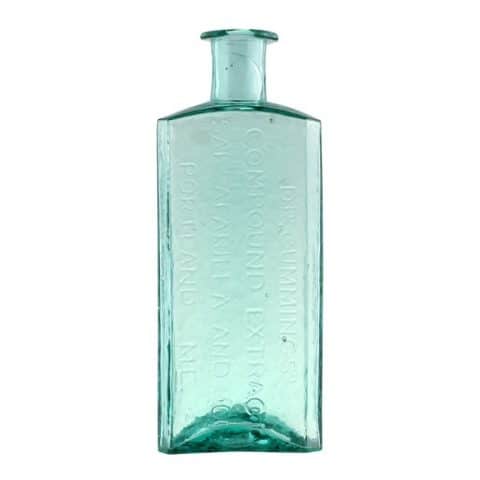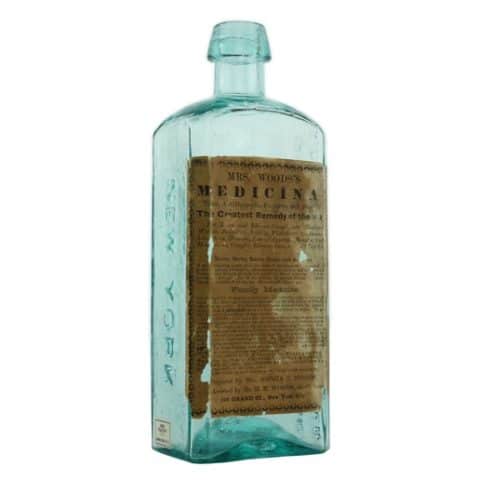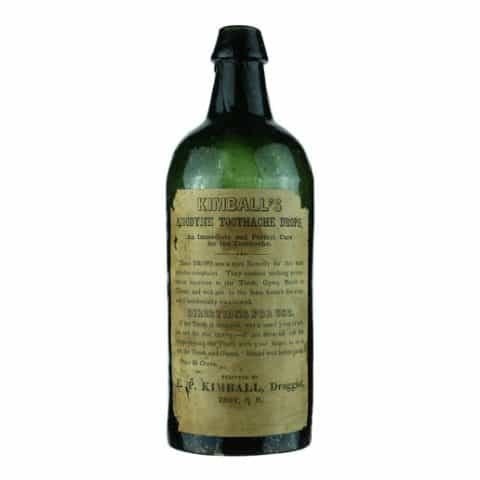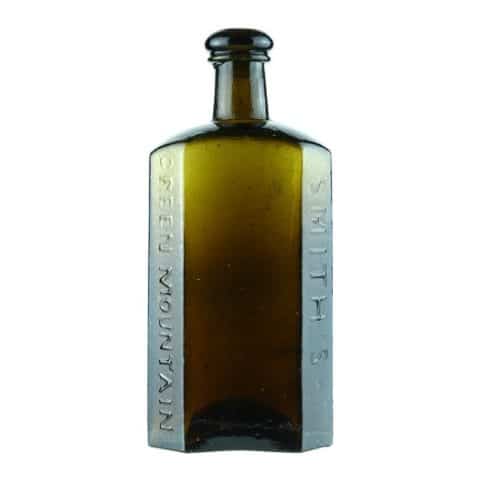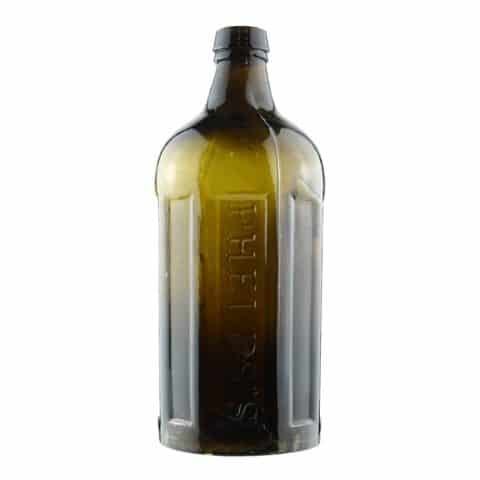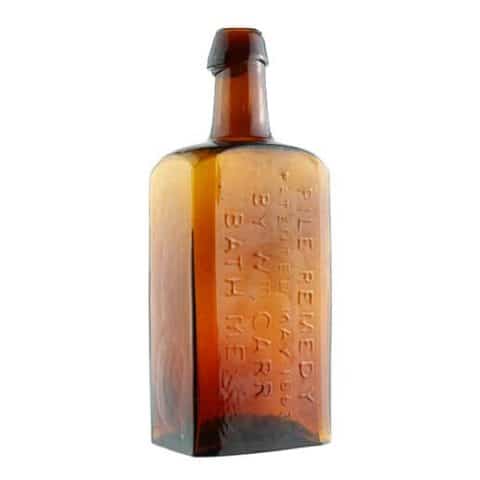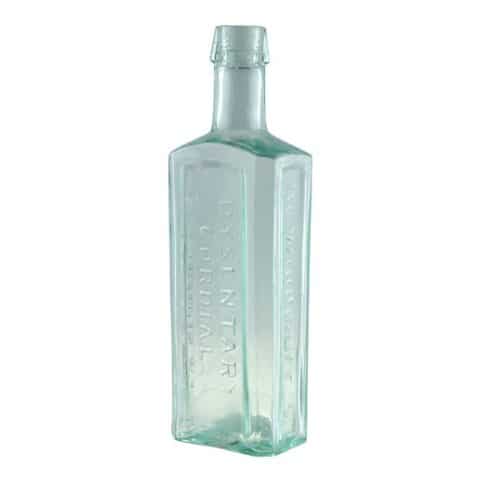Swaim’s Panacea Philada (Round Fluted)
Swaim’s Panacea Philada
William Swaim, Philadelphia, Pennsylvania
Olive Green Cylindrical Medicine
Provenance: Chris Bubash Collection

Swaim’s Panacea was an American patent medicine first hawked in 1820 by William Swaim of Philadelphia, Pennsylvania. Records indicate Swaim was born in New Jersey on February 7, 1781. The medicine was advertised to cure various diseases, including Scrofulous or King’s Evil, Cancers, Mercurial Disease, Deep-seated Syphilis, Rheumatism, Ulcerated Sores, and swellings, to name a few.

Our museum example, produced in a crisp medium olive-green glass, is 7-7/8 inches tall and 3-1/2 inches wide. The cylindrical bottle has 12 indented and chamfered vertical panels. Three are wide, equally spaced, and contain the serifed, base to shoulder embossed copy, ‘SWAIM’S’ (first wide panel), ‘PANACEA’ (second wide panel} and ‘PHILADA’ (third wide panel). Between each of the wider lettered panels are three vertical finger panels. There is a tall domed shoulder, a short neck connecting to a short applied double sloping collared mouth. There is a pontil scarred base. The condition is excellent. The bottle would have been produced between 1840 to 1860 by an unknown glasshouse.

William Swaim
The popular story is that William Swaim was originally a bookbinder who discovered a magical medicinal recipe on the page of a book he was binding at his New York shop. More likely, he obtained the recipe from Dr. N. J. Quackinboss, who had administered it to Swaim. Quackinboss used a formulation previously published by Dr. McNeven, which originated from France, where a remedy called the “Rob de Laffecteur” invented by the French apothecary Pierre Boyveau was very popular. Swaim would doctor the medicine and call it Swaim’s Panacea.
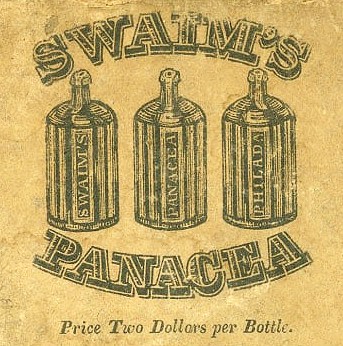
Swaim moved to Philadelphia, set up at No. 63, North Eighth Street, and began to market Swaim’s Panacea. In 1820 he announced his new wonder, supposedly based on sarsaparilla syrup and a dash of mercury, broadly and consistently in the National Gazette (Philadelphia). After getting permission to administer his concoction to some local asylum residents to alleged beneficial effect (and gathering numerous endorsements, including from local physicians), Swaim could initially sell his product at $3 a bottle, a significant sum at the time. In short order, he became very wealthy, with a net worth of approximately $500,000. By 1829, Swaim had reduced the price to “Two Dollars per bottle, thus bringing it within reach of the indigent.“

See the museum example of an earlier rectangular Genuine Swaim’s Panacea Philadelphia bottle.
Swaim used a symbol of Hercules killing Hydra in early advertisements for his product. As with most patent medicines, Swaim backed up his claims with lengthy tributes and testimonials from doctors.

Swaim’s Panacea was initially bottled in rectangular bottles and in round bottles by 1829 that he described as “fluted longitudinally., with the following words blown in the glass—”Swaim’s Panacea–Philada.,” having but one label, which covers the cork, with the signature of Wm. Swaim on it, so that the cork (bearing also upon it as a seal, the impression, “Wm. Swaim,”) cannot be drawn without destroying the signature, without which none is genuine.” Counterfeiting was a big concern, and his ads said it would be punished as a forgery.
The success of Swaim’s Panacea generated many copycat products, including “Swayne’s Panacea,” “Swinn’s Panacea,” and “Parker’s Renovating Vegetable Panacea,” the last of which claimed a lineage older than Swaim and used an image of Hercules having already killed Hydra in its advertising.
By 1828, the Philadelphia Medical Society published a report strongly refuting Swaim’s laudatory claims and previous endorsements of the popular Panacea, as had the New York Medical Society. Respected physicians who had endorsed the product as promising at the beginning, such as Nathaniel Chapman, who later founded the American Medical Association, disavowed their early approvals. Despite Swaim’s claim that the product contained no mercury, the medical reports showed otherwise. Swaim continued unabated.
Swaim took advantage of developments in commercial lithography in the 1830s to label his concoction with a portrait of his son James. By 1840, Wm. Swaim & Son advertised Swaim’s Laboratory as their business. They would use established local and regional drug merchants to distribute their popular product.

Swaim also advertised cases of those patients who have been cured— some of them nearly miraculously by his medicine, including that of Nancy Linton, whose picture, used as a frontispiece to Swaim’s book, illustrates this post. Linton “was attacked with scrofulous swellings of the glands of the neck” when she was twelve. Over the years, her condition worsened to the point of permanent debility even after the application of Swaim’s medicine. He mourns the fact that the dose was not more timely “when she might have been restored a useful member to society, and a prop to her aged and destitute mother.” One might look at this another way as the Panacea contained mercury, and Linton’s appearance appears to reflect signs of mercury poisoning. Mercuric chloride (called corrosive sublimate at the time) did have a prior history of being used to treat syphilis.

William Swaim died in 1846, and his son James continued the business until he died in 1870, along with Swaim’s son-in-law Franklin Stewart. Swaim’s Laboratory was located at 113 S. Seventh Street, just below Chestnut. After 1890, production was moved to Clifton, Staten Island in New York.
In 1900, James F. Ballard of St. Louis, who produced a number of patent medicines, acquired the rights to Swaim’s Panacea and all other Swaim products from the Swaim family. In the 1910s, the United States government fined Ballard $30 for misbranding products under the Pure Food and Drug Act of 1906, including Swaim’s Panacea, as he continued to advertise the product with the extraordinary claims that had then been made for over 90 years. It appears the product continued to be sold at least into the 1920s.
One of the most comprehensive accounts of the story of Swaim’s Panacea is in the 1961 book The Toadstool Millionaires: A Social History of Patent Medicines in America before Federal Regulation by James Harvey Young.

Primary Image: Swaim’s Panacea Philada bottle imaged on location by Alan DeMaison, FOHBC Virtual Museum Midwest Studio.
Secondary Image: Earlier rectangular Genuine Swaim’s Panacea Philadelphia bottle imaged on location by Alan DeMaison, FOHBC Virtual Museum Midwest Studio. Bottle from the Chris Bubash collection. Bottle from American Glass Gallery Auction #29, Lot 251: “GENUINE – SWAIM’S / PANACEA – PHILADELPHIA”, America, 1824 – 1830. Aqua, rectangular with beveled corners, sheared, tooled, outward rolled mouth – blowpipe pontil scar, ht. 7 3⁄4”; (a trace of minor wear, mainly on the back label panel, otherwise attic mint). Odell, p.335. Rare. One of the choicest examples that we have seen, very bold embossing, crude, whittled, and in great condition. These were Wm. Swaim’s first bottles, replaced by the round bottles in 1830.

Support: Reference to The Toadstool Millionaires; a social history of patent medicines in America before Federal regulation by James Harvey Young, 1961, Princeton, N.J., Princeton University Press.
Support Image: Auction Lot 34: “Swaim’s / Panacea / Philada” Medicine Bottle, America, 1830-1850. Cylindrical with three wide embossed vertical panels and nine narrow plain panels, deep olive green, applied sloping collared mouth – pontil scar, ht. 7 5/8 inches; (some very minor wear spots). N #611 Fine condition, beautiful deep color, early bottle. – Norman Heckler Jr. & Sr., Norman C. Heckler & Company, Auction #99
Support Image: Auction Lot 114: “Swaim’s / Panacea / Philada” Medicine Bottle, America, 1860-1870. Cylindrical with vertical panels, medium yellowish green, applied sloping collared mouth with ring – pontil scar, ht. 8 inches; (1-inch iridescent bruise on the interior of the mouth). Similar to N #611 Beautiful bottle, with great color. Gary Hatstat collection. – Norman Heckler Jr. & Sr., Norman C. Heckler & Company, Auction #103
Support Image: Auction Lot 203: “Swaim’s / Panacea / Philada” Medicine Bottle, America, 1840-1860. Cylindrical with indented panels, deep yellow olive, applied sloping collared mouth with ring – pontil scar, ht. 7 7/8 inches, base dia. 3 1/2 inches; (minor manufacturer’s mouth roughness). N #612 Fine condition, great color. Early and crude. – Norman Heckler Jr. & Sr., Norman C. Heckler & Company, Auction #104
Support Image: Auction Lot 88: “Swaim’s / Panacea / Philada” Medicine Bottle, America, 1840-1860. Cylindrical with indented vertical panels, medium olive amber, applied sloping collared mouth with ring – pontil scar, ht. 7 3/4 inches; (minor content residue). AAM pg. 500 A crude example. Fine condition. Kris Kernozicky collection. – Norman Heckler Jr. & Sr., Norman C. Heckler & Company, Auction #107
Support Image: Auction Lot 58: “Swaim’s / Panacea / Phila ” Medicine Bottle, America, 1840-1860. Cylindrical with indented panels, light-medium yellow-green, applied sloping collared mouth with ring – faint pontil scar, ht. 7 3/4 inches, dia. 3 1/2 inches. AAM pg. 500 Retains old cork and exterior dirt. Found at an onsite auction in Iowa. – Norman Heckler Jr. & Sr., Norman C. Heckler & Company, Auction #196
Support Image: Auction Lot 1: “Swaim’s / Panacea / Philada” Medicine Bottle, America, 1840-1860. Cylindrical with indented panels, bright yellow olive, applied sloping collared mouth with ring – pontil scar, ht. 8 inches. N #612 Beautiful lighter color. Fine condition. – Norman Heckler Jr. & Sr., Norman C. Heckler & Company, Auction #110
Support Image: Auction Lot 137: “Genuine / Swaim’s / Panacea / Philadelphia” Medicine Bottle, America, 1840-1860. Rectangular with beveled corners, aquamarine, applied sloping collared mouth – pontil scar, ht. 7 3/8 inches; (professionally cleaned with light wear marks). AAM pg. 500 An attractive early bottle that precedes the more common cylindrical fluted “Swaim’s” bottles. – Norman Heckler Jr. & Sr., Norman C. Heckler & Company, Auction #131
Support Image: 208: “SWAIM’S – PANACEA – PHILADA.”, (Odell, pg. 335), Pennsylvania, ca. 1840 – 1860, light greenish aqua, 8”h, tubular open pontil, applied tapered collar mouth. Lightly cleaned to perfect condition. Very rare coloration, usually seen in various shades of green and olive green and almost never with an open pontil. And this is the variant that lacks the label panel. No collection of Swaim’s Panacea bottles would be complete without this one! – Jim Hagenbuch, Glass Works Auctions
Support Image: Labeled Swaim’s Panacea – Smithsonian National Museum of American History
Join the FOHBC: The Virtual Museum is a project of the Federation of Historical Bottle Collectors (FOHBC). To become a member.

















